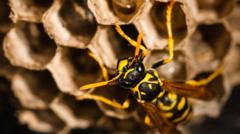A bizarre yet alarming incident has unfolded at the Savannah River Site (SRS) in South Carolina, where federal officials recently reported the discovery of a radioactive wasp nest with radiation levels measured at ten times the permissible limit. The nest, reportedly found on July 3 by routine safety inspectors at the facility once heavily involved in nuclear weapons production, has been treated and disposed of as radiological waste.
Although the U.S. Department of Energy insists that this contamination does not stem from any recent nuclear waste leak and has not impacted public or environmental safety, the news has raised eyebrows. Environmental groups have voiced their concerns regarding the federal government's transparency and communication about the situation, particularly given the site's past history of handling hazardous materials during the Cold War era.
The wasp nest was found located close to storage tanks containing millions of gallons of liquid nuclear waste. Investigators highlighted that there was “no contamination in the area” surrounding the nest. They attributed the high radiation levels found in the nest to what is described as “onsite legacy radioactive contamination,” a term that reflects residual radioactivity from the site’s earlier operations, which included creating plutonium components for nuclear arsenals.
According to the report, the wasps inhabiting the nest would have had much lower radiation exposure compared to the nest itself, as wasps typically remain within a limited flight range of their nests. Despite the assurances provided, watchdog group Savannah River Site Watch expressed their dissatisfaction, questioning the origins of the radioactive material and raising potential concerns over other undetected leaks.
With SRS being home to 43 underground tanks still operational and a historical record of generating over 165 million gallons of liquid nuclear waste, the lingering effects of such practices remain a critical concern for local communities and environmental advocates.


















